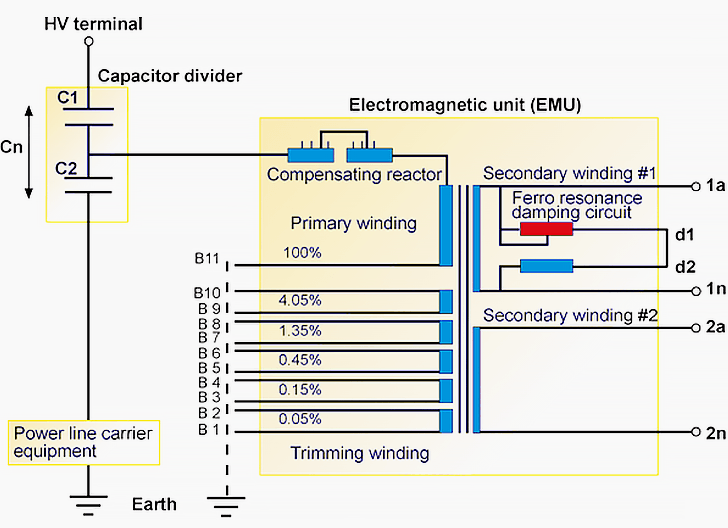Transformers (CVT) For HV Measurements
66 kV and upwards //
Capacitive voltage transformers (CVTs) are used on higher voltage levels, starting from 66 kV and upwards. The type of the CVT is always a single-pole one, thus the connection is between phase and earth. The higher the voltage level is, the more price-competitive the capacitive type becomes.
One of the advantages the capacitive type has, in comparison to the inductive type, is the possibility to use capacitive voltage transformers as high-frequency coupling unitstowards the primary system (over headlines).
A typical application would be to utilize the CVTs for power line carrier (PLC)high-frequency signal interface units. For the voltage measurement purposes, the behavior and the data specification of CVTs follow the same guide lines as the inductive ones.
In addition, the possibility for high-frequency signal coupling calls for a specified value for rated capacitance (Cn).
This value is chosen considering the following issues //
Voltage magnitude to be measuredDemands from PLC system (frequency, bandwidth, connections)Capacitive voltage transformer manufacturing considerations
The construction of capacitive voltage transformers
The figure above shows the principle of a capacitive voltage divider on which the capacitive voltage transformer is based. The trimming windings are used for fine tuning the output signal to correspond with the required accuracy class requirements. The compensating reactor compensates the phase angle shift caused by the capacitive voltage divider.
All capacitive voltage transformers require some sort of ferroresonance damping circuit.
The capacitance in the voltage divider, in series with the inductance of the compensating reactor and the wound transformer (inside the electromagnetic unit EMU), constitutes a tuned resonance circuit. Unlike with the inductive type of voltage transformers the CVTs usually have the ferroresonance damping circuit inbuilt in the CVT itself, as shown in the previous figure.
At higher system voltages, the resonance phenomenon usually takes place on fundamental or on sub-harmonic frequencies, resulting in voltage transformer heating (finally damages) and non-selective operations of protective relaying possible protective relaying non-selective operations.
The modern CVTs are utilizing the so-called “adaptive” damping circuits.
The circuit consists of a saturable series reactor and a loading resistor. This circuit is connected in parallel to one of the secondary cores. During ferroresonance conditions, high voltages appear, saturating the reactor and turning the damping resistor on to effectively mitigate the parasitic voltage. During normal system conditions, the reactor presents high reactance, effectively “switching off” the damping resistor.
Possible triggering factors for the ferroresonance phenomena could be //
Planned primary switchings in the systemCircuit breaker trippings caused by primary faultHigh-speed autoreclosing
































Very informative blog. thank you for sharing. keep posting.
ReplyDeletePower Transformers in India | Transformer Manufacturer in India